Related Research Articles

Cecil County is a county located in the U.S. state of Maryland at the northeastern corner of the state, bordering both Pennsylvania and Delaware. As of the 2020 census, the population was 103,725. The county seat is Elkton.
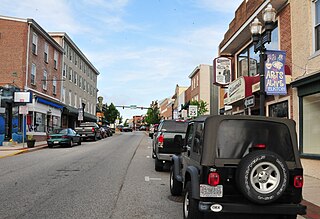
Elkton is a town in and the county seat of Cecil County, Maryland, United States. The population was 15,443 at the 2010 census. It was formerly called Head of Elk because it sits at the head of navigation on the Elk River, which flows into the nearby Chesapeake Bay. The town constitutes part of the Delaware Valley.

Port Deposit is a town in Cecil County, Maryland, United States. It is located on the east bank of the Susquehanna River near its discharge into the Chesapeake Bay. The population was 653 at the 2010 census.

The Eastern Shore of Maryland is a part of the U.S. state of Maryland that lies mostly on the east side of the Chesapeake Bay. Nine counties are normally included in the region. The Eastern Shore is part of the larger Delmarva Peninsula that Maryland shares with Delaware and Virginia.
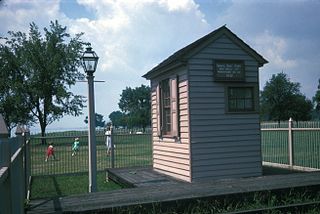
The New Castle and Frenchtown Turnpike and Rail Road (NC&F) was opened in 1831, was the first railroad in Delaware and one of the first in the United States. About half of the route was abandoned in 1859; the rest became part of the Pennsylvania Railroad (PRR) route into the Delmarva Peninsula and is still used by Norfolk Southern Railway. The abandoned segment from Porter, Delaware, to Frenchtown, Maryland, the New Castle and Frenchtown Railroad Right-of-Way, was listed on the National Register of Historic Places in 1976.

The Philadelphia, Wilmington and Baltimore Railroad (PW&B) was an American railroad that operated independently from 1836 to 1881. Headquartered in Philadelphia, it was greatly enlarged in 1838 by the merger of four state-chartered railroads in three Mid-Atlantic states to create a single line between Philadelphia and Baltimore.

David Hazzard was an American merchant and politician from Milton, in Sussex County, Delaware. He was a member of the Democratic-Republican Party, then the National Republican Party, and finally the Whig Party. He served in the Delaware General Assembly, as Governor of Delaware, and as an associate justice of the Delaware Superior Court.

The Northern Central Railway (NCRY) was a Class I Railroad in the United States connecting Baltimore, Maryland, with Sunbury, Pennsylvania, along the Susquehanna River. Completed in 1858, the line came under the control of the Pennsylvania Railroad (PRR) in 1861, when the PRR acquired a controlling interest in the Northern Central's stock to compete with the rival Baltimore and Ohio Railroad (B&O).

Maryland Route 7 (MD 7) is a collection of state highways in the U.S. state of Maryland. Known for much of their length as Philadelphia Road, there are five disjoint mainline sections of the highway totaling 40.23 miles (64.74 km) that parallel U.S. Route 40 (US 40) in Baltimore, Harford, and Cecil counties in northeastern Maryland. The longest section of MD 7 begins at US 40 just east of the city of Baltimore in Rosedale and extends through eastern Baltimore County and southern Harford County to US 40 in Aberdeen. The next segment of the state highway is a C-shaped route through Havre de Grace on the west bank of the Susquehanna River. The third mainline section of MD 7 begins in Perryville on the east bank of the Susquehanna River and ends at US 40 a short distance west of the start of the fourth section, which passes through Charlestown and North East before ending at US 40, just west of Elkton. The fifth segment of the highway begins at South Street and passes through the eastern part of Elkton before reconnecting with US 40 east of Elkton and west of the Delaware state line.

Maryland Route 281 is a state highway in the U.S. state of Maryland. Known for most of its length as Red Hill Road, the state highway runs 2.12 miles (3.41 km) from MD 7 east to the Delaware state line in Elkton in northeastern Cecil County. MD 281 and its continuation in Delaware were originally blazed in the 18th century as part of the Old Post Road between Baltimore and Philadelphia. The route was part of the Elk and Christiana Turnpike in the early 19th century and later the Old Baltimore Pike, but it was replaced as the main highway east from Elkton by U.S. Route 40 in the early 20th century. MD 281 was constructed in Elkton in the early 1930s. The highway designation was extended east to the state line in the late 1950s; that extension was reconstructed in the early 1960s.

Maryland Route 222 (MD 222) is a state highway in the U.S. state of Maryland. The highway runs 11.36 miles (18.28 km) from MD 7 in Perryville north to U.S. Route 1 (US 1) near Conowingo. MD 222 connects Perryville, Port Deposit, and Conowingo along its route paralleling the Susquehanna River in western Cecil County. Due to limitations in the highway in Port Deposit, including a steep hill and a low-clearance railroad bridge, trucks are directed to use MD 275, MD 276, and US 1 through Woodlawn and Rising Sun to connect Interstate 95 (I-95) with US 222 in Conowingo.
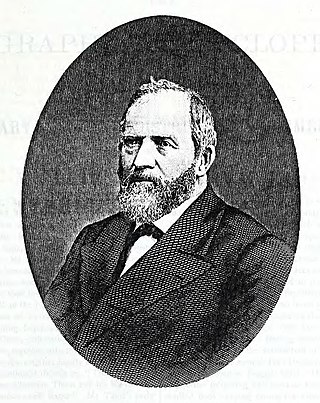
Jacob Tome was an American banker, philanthropist, and politician who died as one of the richest men in the United States. He was the first millionaire of Cecil County, Maryland, and an accomplished philanthropist, giving money to colleges, churches, and schools, including establishing the Tome School.
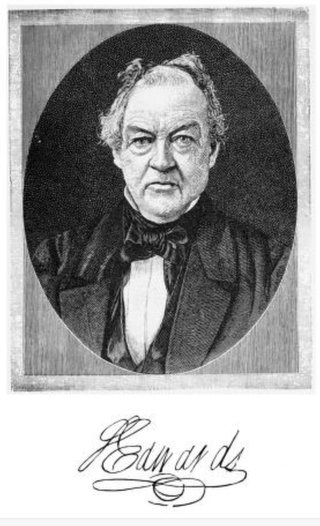
Samuel Edwards was an American politician from Pennsylvania who served as a member of the U.S. House of Representatives from Pennsylvania's 1st congressional district from 1819 to 1823 and from Pennsylvania's 4th congressional district from 1823 to 1827.
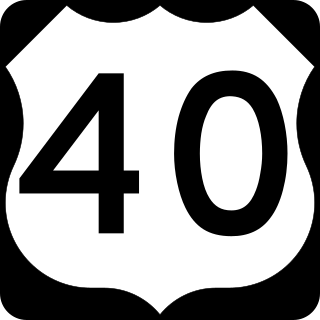
U.S. Route 40 in the U.S. state of Maryland runs from Garrett County in Western Maryland to Cecil County in the state's northeastern corner. With a total length of 221 miles (356 km), it is the longest numbered highway in Maryland. Almost half of the road overlaps or parallels with Interstate 68 (I-68) or I-70, while the old alignment is generally known as US 40 Alternate, US 40 Scenic, or Maryland Route 144. West of Baltimore, in the Piedmont and Appalachian Mountains / Blue Ridge region of the Western Maryland panhandle of the small state, the portions where it does not overlap an Interstate highway are mostly two-lane roads. The portion northeast of Baltimore going toward Wilmington in northern Delaware and Philadelphia in southeastern Pennsylvania is a four-lane divided highway, known as the Pulaski Highway. This section crosses the Susquehanna River at the north end of the Chesapeake Bay on the Thomas J. Hatem Memorial Bridge.

Holly Hall is a historic home located at Elkton, Cecil County, Maryland, United States. Built by James Sewall ca. 1810–20, it is a 2+1⁄2-story, Federal-style brick mansion built about 1810. The one-story brick north wing was added as a chapel in the 20th century. Also on the property is a late-19th-century two-story wood tenant house and two concrete block buildings. A few holly trees remain of the many which gave this house its name. Its parapets are unique in Maryland.
Frenchtown was a historic settlement on the Elk River in Cecil County, Maryland, United States.

Old Baltimore Pike is a road in the U.S. state of Delaware. The road, known as New Castle County Road 26, runs from Maryland Route 281 (MD 281) at the Maryland state line south of Newark, Delaware, and continues east to Christiana, ending near Delaware Route 1 (DE 1). The road is paralleled by Interstate 95 to the north and U.S. Route 40 to the south. The Old Baltimore Pike was built before 1720 and connected Elkton, Maryland, to Christiana. It was a turnpike called the Elk and Christiana Turnpike between 1817 and 1838. In the past it served as a major connection between Philadelphia and Baltimore.

The Raid on Havre de Grace was a seaborne raid that took place on 3 May 1813 during the broader War of 1812. A squadron of the British Royal Navy under Rear Admiral George Cockburn attacked the town of Havre de Grace, Maryland, at the mouth of the Susquehanna River. Cockburn's forces routed the town's defenders and sacked and burnt several buildings before withdrawing.

Elkton station is a former passenger rail station located in Elkton, Maryland. The last passenger service to the station was Amtrak's Chesapeake from 1978 to 1983. The brick station building still remains along the Northeast Corridor tracks.
References
- 1 2 3 4 5 6 "National Register of Historic Places Nomination Form: Holly Hall" (PDF). U.S. Department of the Interior. April 16, 1968. Retrieved December 2, 2013.
- ↑ Death of James M. Sewall, Esq.
- ↑ "To James Madison from the Republican Meeting of Cecil County, Maryland, [22 February] 1810". Founders Online. National Archives and Records Administration. Retrieved December 2, 2013.
- ↑ Sheads, Scott S. (27 March 2011). "Frenchtown: April 29, 1813 – Cecil County" . Retrieved December 2, 2013.
- ↑ Maryland, a Guide to the Old Line State. Maryland: Federal Writers' Project. 1940. ISBN 9781623760199.
- ↑ "An Act to Incorporate a Company to make a Turnpike Road from Elkton to the site of the proposed Bridge near Rock Run". William Kilty et al., (eds).The Laws of Maryland from the End of the Year 1799. Maryland State Archives. 1817. Archived from the original on 3 Dec 2013. Retrieved December 2, 2013.
- ↑ Carstens, Patrick Richard (2011). Searching For the Forgotten War - 1812. Xlibris. ISBN 9781456867553.
- ↑ Wilson, William Bender (1895). History of the Pennsylvania Railroad Company with Plan of Organization, Portraits of Officials and Biographical Sketches. Vol. 1. Philadelphia: Henry T. Coates & Company. pp. 296–299. Retrieved November 25, 2012.